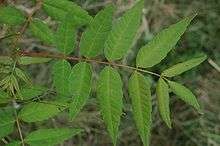Toona sinensis
| Toona sinensis | |
|---|---|
 | |
| Foliage and seed capsules | |
| Scientific classification | |
| Kingdom: | Plantae |
| (unranked): | Angiosperms |
| (unranked): | Eudicots |
| (unranked): | Rosids |
| Order: | Sapindales |
| Family: | Meliaceae |
| Genus: | Toona |
| Species: | T. sinensis |
| Binomial name | |
| Toona sinensis (A.Juss.) M.Roem. | |
| Synonyms | |
| |

Toona sinensis, with common names Chinese mahogany,[2] Chinese toon, or red toon (Chinese: 香椿; pinyin: xiāngchūn; Hindi: daaraluu; Malay: suren; Vietnamese: tông dù) is a species of Toona native to eastern and southeastern Asia, from North Korea south through most of eastern, central and southwestern China to Nepal, northeastern India, Myanmar, Thailand, Malaysia, and western Indonesia.[3][4][5][6][7]

It is a deciduous tree growing to 25 metres (82 ft) tall with a trunk up to 70 cm diameter. The bark is brown, smooth on young trees, becoming scaly to shaggy on old trees. The leaves are pinnate, 50–70 cm long and 30–40 cm broad, with 10–40 leaflets, the terminal leaflet usually absent (paripinnate) but sometimes present (imparipennate); the individual leaflets 9–15 cm long and 2.5–4 cm broad, with an entire or weakly serrated margin. The flowers are produced in summer in panicles 30–50 cm long at the end of a branch; each flower is small, 4–5 mm diameter, with five white or pale pink petals. The fruit is a capsule 2–3.5 cm long, containing several winged seeds.[3][6][7][8]
Cultivation and uses
The young leaves of T. sinensis (xiāngchūn) are extensively used as a vegetable in China; they have a floral, yet onion-like flavor, attributed to volatile organosulfur compounds.[9] Plants with red young leaves are considered of better flavour than those where the young leaves are green.[3][10][11]
The timber is hard and reddish; it is valuable, used for furniture making [3][8] and for bodies of electric guitars. Being a "true mahogany" (mahogany other than Swietenia), it is one of the common replacements for Swietenia mahogany ("genuine mahogany") which is now commercially restricted from being sourced natively.[12]
Outside of its native region T. sinensis is valued more as a large ornamental tree for its haggard aspect.[7][13] It is by far the most cold-tolerant species in the Meliaceae and the only member of the family that can be cultivated successfully in northern Europe.
Culture
In Chinese literature, Toona sinensis is often used for a rather extreme metaphor, with a mature tree representing a father. This manifests itself occasionally when expressing best wishes to a friend's father and mother in a letter, where one can write "wishing your Toona sinensis and daylily are strong and happy" (simplified Chinese: 椿萱并茂; traditional Chinese: 椿萱並茂; pinyin: chūnxuānbìngmào), with Toona sinensis metaphorically referring to the father and daylily to the mother.
See also
References
- ↑ http://www.theplantlist.org/tpl/record/kew-2515062
- ↑ Yousheng, C.; Sziklai, O. (1985), "Preliminary study on the germination of Toona sinensis (A. Juss.) roem. seed from eleven Chinese provenances", Forest Ecology and Management, 10 (3): 269–281, doi:10.1016/0378-1127(85)90119-7
- 1 2 3 4 Hua Peng, David J. Mabberley, Caroline M. Pannell, Jennifer M. Edmonds & Bruce Bartholomew. "Toona sinensis". Flora of China. Missouri Botanical Garden, St. Louis, MO & Harvard University Herbaria, Cambridge, MA. Retrieved 25 May 2012.
- ↑ Germplasm Resources Information Network: Toona sinensis
- ↑ University of Melbourne: Sorting Toona names
- 1 2 Hong Kong trees: Toona sinensis (in Chinese, with photos; google translation)
- 1 2 3 Rushforth, K. (1999). Trees of Britain and Europe. Collins ISBN 0-00-220013-9.
- 1 2 Taiwan Forestry: Toona sinensis (in Chinese, with photos; google translation)
- ↑ Li J.-X., Eidman K., Gan X.-W., Haefliger O. P., J. Carroll P. J., Pika J. "Identification of (S,S)‑γ-glutamyl‑(cis-S‑1-propenyl)thioglycine, a naturally occurring norcysteine derivative, from the Chinese vegetable Toona sinensis." Journal of Agricultural and Food Chemistry 2013 61 (7470−7476).
- ↑ Plants for a Future: Toona sinensis
- ↑ Oriental Vegetable Seeds: Toona sinensis
- ↑ "Press Release UNEP/181_Cites Trade Controls to Take Effect for Mahogany".
- ↑ More, D. & White, J. (2003). Cassell's Trees of Britain & Northern Europe. London: Weidenfeld & Nicolson. p. 709
Further reading
- Wang, Kai-Jin, Chong-Ren Yang, and Ying-Jun Zhang. "Phenolic antioxidants from Chinese toon (fresh young leaves and shoots of Toona sinensis)."Food Chemistry 101.1 (2007): 365-371.